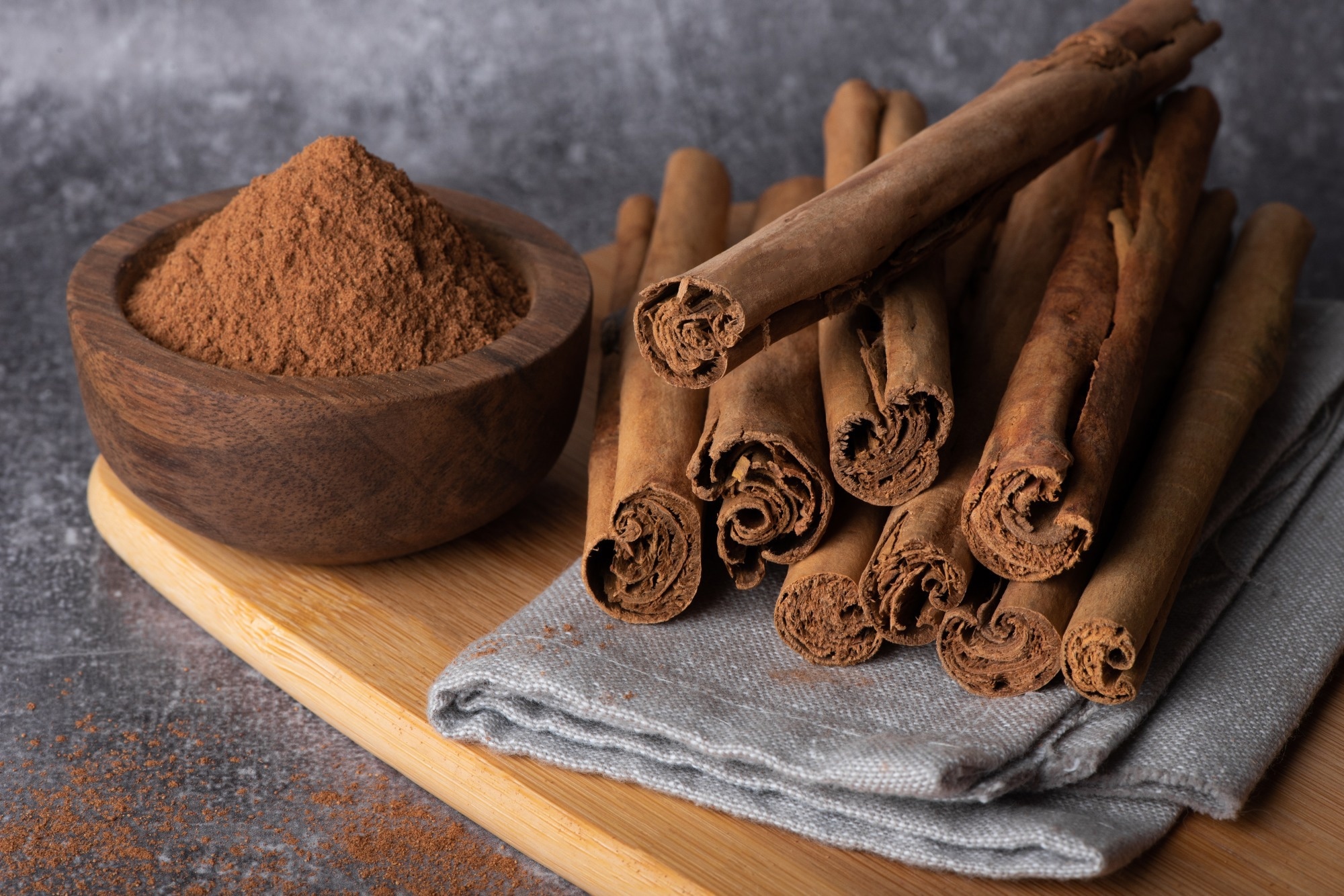In a recent study published in the journal Nutrients, researchers examine the effects of cinnamon on adipocyte differentiation and lipid accumulation.
Study: Effects of Cinnamon (Cinnamomum zeylanicum) Extract on Adipocyte Differentiation in 3T3-L1 Cells and Lipid Accumulation in Mice Fed a High-Fat Diet. Image Credit: Annmell_sun / Shutterstock.com
The health benefits of cinnamon
Obesity is caused by fat accumulation due to unhealthy dietary patterns, unregulated sleeping routines, and low physical activity. Adipocyte differentiation is highly related to obesity through fat production and accumulation.
Cinnamon has diverse health benefits, including anti-inflammatory properties and blood glucose regulation. In fact, several studies have reported that cinnamon reduces the risk of various cancers.
Cinnamon is popular as a spice, nutrition, and traditional medicine. Diets supplemented with cinnamon have antioxidant, antidiabetic, anti-inflammatory, anti-cancer, and anti-microbial effects. While numerous studies have examined the effects of cinnamon on diabetes and insulin disorders, there is limited research regarding its impact on obesity.
About the study
In the present study, researchers assess the effects of cinnamon extract on the differentiation of adipocytes and lipid accumulation. To this end, a cinnamon extract was prepared by vacuum evaporating and freeze-drying Ceylon cinnamon powder.
Subsequently, 3T3-L1 pre-adipocytes were treated with increasing concentrations of cinnamon extract from one to 10 µg/ml. Cellular lipid levels were estimated by Oil Red O staining. Messenger ribonucleic acid (mRNA) levels were analyzed 24 hours after treatment.
In mice, the regular AIN-93G diet was supplemented with cinnamon extract, whereas other mice were fed a high-fat diet (HF) with 45% fat. C57BL/6J mice were randomized to be fed ND, ND supplemented with cinnamon (NC), HF, or HF supplemented with cinnamon (HC) for 14 weeks.
The mice’s food intake and body weight were measured, and the food efficiency ratio (FER) was calculated. The final body weight of the mice was recorded before euthanasia.
Blood samples were obtained, and the weight of the liver, lungs, brain, abdominal fat, kidneys, and epididymal fat was recorded. Serum triglyceride (TG), total cholesterol (TC), and high-density lipoprotein cholesterol (HDL-C) levels were also measured.
Low-density lipoprotein cholesterol (LDL-C) and very LDL-C (VLDL-C) were estimated using Friedewald’s equation. Cardiac risk indices I (CRI-I) and II (CRI-II) and the atherogenic index (AI) were also calculated.
Hepatic TG and TC levels and the activity of hormone-sensitive lipase (HSL) in white adipose tissue (WAT) and the liver were also determined. Western blotting was performed to measure protein levels of adipogenic, lipid synthesis, and lipolysis markers in the liver.
Study findings
Cell viability assays indicated that cinnamon extract concentrations of 10 µg/ml or less were not cytotoxic. Furthermore, treating 3T3-L1 pre-adipocytes with 10 µg/ml of cinnamon significantly inhibited their differentiation into mature cells and increased gene expression of leptin, peroxisome proliferator-activated receptor-gamma (Pparγ), adiponectin, and carnitine palmitoyl transferase 1 (CPT-1).
This high dose also reduced the expression of fatty acid synthase (FAS), acetyl coenzyme A carboxylase (ACC), and sterol regulatory element-binding protein 1c (SREBP-1c) genes. AMP-activated protein kinase (Ampk) levels increased with the treatment dose but did not reach statistical significance.
Cinnamon-supplemented diet groups were associated with significantly lower weight gain than non-cinnamon-supplemented diet groups. There were no differences in food intake across groups throughout the intervention. The FER of the NC or HC group was significantly lower than the ND and HF groups.
Mice in the HF group had the highest abdominal and epididymal fat weight. The HF group had higher TG, LDL-C, VLDL-C, and TC levels than ND-fed mice; however, there were no significant differences in HDL-C levels.
HC-fed mice exhibited significantly lower levels of VLDL-C and TG than HF- or ND-fed mice. Furthermore, the HC group had substantially higher levels of HDL-C than the other groups.
Compared to ND-fed mice, the HF group exhibited significantly increased AI, CRI I, and CRI II. The AI in HC-fed mice was considerably lower than in HF- or ND-fed mice. While the HC group showed a significantly lower CRI I than the HF group, it was not significantly different from the NC and ND groups.
Hepatic HSL activity significantly decreased in HF-fed mice, whereas HSL activity in WAT was lowest in the HF group. The HC group exhibited substantially higher hepatic and WAT HSL activity and significantly smaller epididymal and abdominal adipose tissue sizes than the HF group.
Western blot analysis demonstrated that phosphorylated ACC levels were lowest in HF-fed mice and significantly higher in HC-fed mice than in the HF group. CPT-1 expression was highest in ND-fed mice; however, there were no significant differences between the HF and cinnamon-supplemented diet groups. FAS expression was highest in HF-fed mice, which had significantly lower levels of FAS than HF-fed mice.
Conclusions
Cinnamon supplementation inhibited lipid accumulation, reduced the expression of adipogenesis genes, and increased lipolysis in 3T3-L1 cells. Furthermore, VLDL-C levels were reduced, whereas HDL-C levels increased with cinnamon supplementation, which corroborates the anti-dyslipidemia effects. Lipolysis was also induced in mice fed a high-fat diet supplemented with cinnamon.
The study findings illustrate that cinnamon extract supplementation inhibits lipogenesis and lipid accumulation and promotes lipolysis.
Journal reference:
- Oh, J., Ahn, S., Zhou, X., et al. (2023). Effects of Cinnamon (Cinnamomum zeylanicum) Extract on Adipocyte Differentiation in 3T3-L1 Cells and Lipid Accumulation in Mice Fed a High-Fat Diet. Nutrients. doi:10.3390/nu15245110
Credit: Source link




